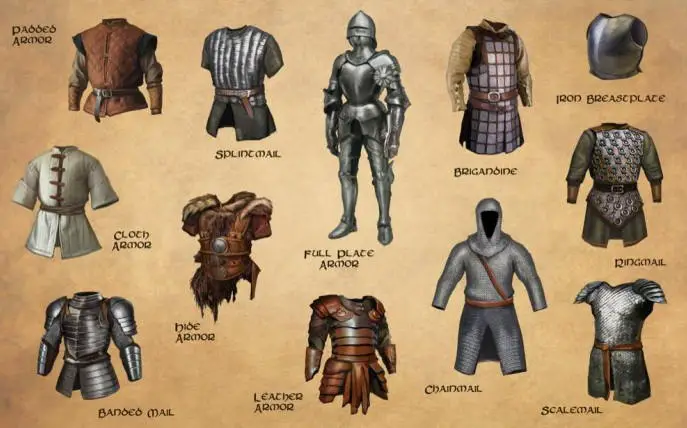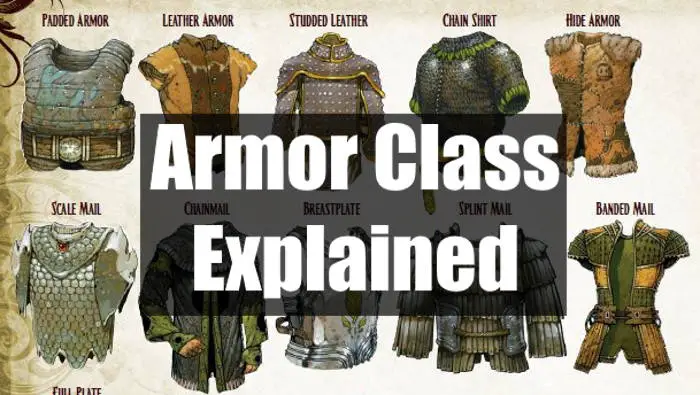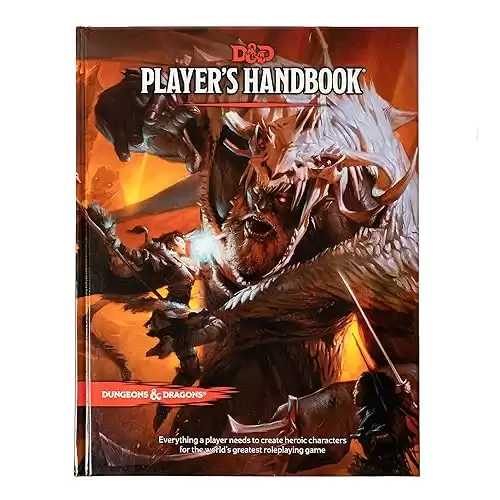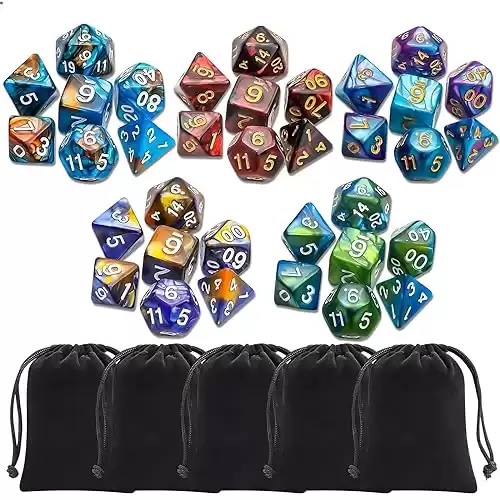Combat plays a huge role in DnD, both in how you build your character and how you play the game. Most players think about their weapons or spells, but how you protect yourself is just as important. Armor Class is something every character will use, so you should know how the system works and how to keep your defenses high.
A creature’s Armor Class (AC) is the lowest number you need to hit them with an attack roll. The higher your Armor Class is, the more likely it is that attacks will miss against you. As a result, most players highly prioritize having a good AC, and they’ll try to increase it throughout a campaign. Armor Class can be affected by your ability scores, usually Dexterity, or by your equipment. There are also plenty of spells and items that can increase your AC.
Understanding AC is key for players and DMs alike. If you want to learn more about this system works, or if you’re trying to get your AC as high as it can go, then look no further! This article will tell you everything you need to know about Armor Class in DnD.
How Does Armor and Armor Class Work in DnD 5e?
Every character and monster has an Armor Class, which represents how well it can block or dodge attacks. When you make an attack roll, you only hit if the result is equal to or greater than the target’s AC. Let’s take a look at an example to understand how this system works in-game.
If you want to hit a Beholder with your longsword, you first have to make an attack roll. Let’s say you roll a 10 on the d20, and you add your attack bonus of +8 for a total of 18. Next, the DM compares your result to the Beholder’s AC. It has an AC of 18, which ties the result of your attack roll.
Since a creature’s AC is the minimum number required to hit it, your longsword strikes the monster, and you get to roll damage. If your attack roll had been any lower, the attack would’ve missed and done no damage.
As you can see from this example, Armor Class is the most common line of defense in DnD. Even if you have lots of HP, you’ll also want to have a high Armor Class so you aren’t constantly taking damage.
How Is Armor Class Calculated?
Now that you know how Armor Class works, you might be wondering where this number comes from. The answer depends on what equipment your character is wearing, as well as what their ability scores are.
A character can wear one type of armor at a time, and each type provides a different base AC. Leather armor, for example, makes your AC 11 + your Dex modifier. Chain Mail, on the other hand, makes your AC 16. It’s important to note that if your armor uses your Dexterity, your AC will actually be decreased if your modifier is negative. This is one of many reasons why Dexterity is such an important ability in 5e.
Some characters, however, don’t wear any armor. This is especially common for Sorcerers and Wizards, who aren’t proficient with any armor types. In these cases, your base AC is 10 + your Dex modifier.
After calculating your armor’s AC, you add any bonuses from other equipment. Shields give you a +2 bonus to AC, and you can gain other bonuses through magic items, spells, and more.
What Are The Types of Armor in DnD 5e?
There are three major types of armor in DnD: Light, Medium, and Heavy. Each set of armor falls into one of these three categories, and your character can be proficient with any number of them.
It’s important to note that you can technically wear any suit of armor you want. However, there are serious penalties for wearing armor that you’re not proficient in. Wearing armor that you aren’t proficient in gives you disadvantage on ability checks, attack rolls, and saving throws. In addition, you can’t cast spells while wearing that armor. As a result, almost all characters will stick with the armor types they’re proficient in.

On the topic of proficiency: you don’t add your proficiency bonus to your AC just because you are proficient with your armor. Proficiency with armor just lets you wear it without penalties; it doesn’t give you any extra bonuses.
Just like in real life, some armor is especially noisy. It’s hard to keep quiet while you’re wearing a suit of metal, so some armor gives you disadvantage on stealth checks. This is usually a trade-off for a higher base AC, so you’ll need to consider your campaign and your role in the party when choosing your armor.
Armor Tables
Light armor works best with characters that have a high Dexterity score. This armor doesn’t give you much protection by itself, but classes like Rangers and Rogues can still have a decent AC while wearing this armor.
| Light Armor | Cost | Armor Class | Stealth | Weight |
| Padded | 5 gp | 11 + Dex modifier | Disadvantage | 8lbs |
| Leather | 10 gp | 11 + Dex modifier | – | 10lbs |
| Studded Leather | 45 gp | 12 + Dex modifier | – | 13lbs |
Medium armor works well for a variety of classes. It gives you a solid base AC on its own, and you can increase it further just by having a decent Dex mod. The biggest downside to this armor is that unlike light armor, you can’t keep increasing your Dex to get a better AC. Once your Dex mod is +2, you’ll need better equipment for a better AC.
| Medium Armor | Cost | Armor Class | Stealth | Weight |
| Hide | 10 gp | 12 + Dex modifier (max +2) | – | 12lbs |
| Chain Shirt | 50 gp | 13 + Dex modifier (max +2) | – | 20lbs |
| Scale Mail | 50 gp | 14 + Dex modifier (max +2) | Disadvantage | 45lbs |
| Breastplate | 400 gp | 14 + Dex modifier (max +2) | – | 20lbs |
| Half Plate | 750 gp | 15 + Dex modifier (max +2) | Disadvantage | 40lbs |
Heavy armor offers the best protection, but it comes at a cost. All heavy armor gives you disadvantage on stealth checks, and your speed can be reduced by 10 ft. if your strength isn’t high enough. For tanky builds, like fighters or paladins, this is a great option for keeping you safe while in melee.
| Heavy Armor | Cost | Armor Class | Strength | Stealth | Weight |
| Ring Mail | 30 gp | 14 | – | Disadvantage | 40lbs |
| Chain Mail | 75 gp | 16 | Str 13 | Disadvantage | 55lbs |
| Splint | 200 gp | 17 | Str 15 | Disadvantage | 60lbs |
| Plate | 1,500 gp | 18 | Str 15 | Disadvantage | 65lbs |
Can Race or Class Change Armor Class in 5e?
Yes! What race or class you choose for your character can make a big difference in your final AC. Some options give you bonuses to AC, such as how the ‘Defense’ Fighting Style can give a +1 to your paladin. Other options o further by giving you alternative ways to calculate your base AC.
If a class or race gives you a new way to calculate your base AC, you have to choose between that method and wearing armor. In fact, these alternative ways require you to be unarmored. Some of these features may allow you to also wear shields, but others do not.
The two classes that always provide an alternative base AC are barbarians, as I’ve already mentioned, and monks. Both classes have a feature called Unarmored Defense that add additional modifiers to your AC:
- Barbarian: 10 + your Dex modifier + your Con modifier
- Monk: 10 + your Dex modifier + your Wis modifier
Some subclasses also give you new ways to calculate your base AC. A common example is the Draconic Bloodline sorcerer, which makes your unarmored AC 13 + your Dex mod. This is especially useful because sorcerers don’t have any armor proficiencies, as well as having low HP. As a result, sorcerers are fragile on the battlefield, so having an enhanced Armor Class is a significant benefit.
Finally, some races or monsters also have natural armor that improves your AC. Lizardfolk, for example, have a base AC of 13 + your Dex mod when unarmored. Tortles can’t even wear armor, but have a base AC of 17. If you choose to play as one of these races, you still have to choose between their natural armor and other ways of calculating base AC.
How Can I Increase My Armor Class in 5e?
By now, you have your base AC figured out. As your campaign progresses and you face more dangerous threats, however, you might want some extra protection. How do you improve your AC throughout a game, and what are the different methods you can use?
The most common way to improve your AC is by buying better armor. This is a pretty obvious method, but it’s something to really consider when you have extra gold to spend. If you keep your starting armor throughout the whole game because you wanted to buy other weapons and items, you might find that your defenses are lacking in the later-levels.
Another common method is to improve the relevant ability scores. This is especially important if you use light armor or no armor because there’s no limit to the bonus you get from your Dex mod. It’s still important for other armor types, though. Medium armor incentivizes you to invest at least a little into your Dexterity, and heavy armor penalizes you if your strength isn’t high enough.
Beyond those, there are other options for improving your AC during a campaign.
Spells

One of the best ways to improve your AC during key battles is to use defensive spells. These are especially useful for sorcerers and wizards because their AC is naturally very low. While I won’t be covering every spell that increases AC, these are some of the best 1st-level options that can be useful throughout a campaign.
Mage Armor sets the base AC of a willing creature to 13 + their Dex modifier. Usually, this spell will be used on the caster, but it can be used on any creature the caster can touch. It can’t be used on creatures wearing armor, so it’s an excellent option for spellcasters.
Shield is a reaction that you can use after you’re hit by an attack roll. It gives you a +5 AC until the start of your next turn, including against the attack that triggered it. This can potentially save you from a devastating attack, as well as protect you for the rest of the round.
The only catch here is that you don’t get to know how high the attack roll was against you, so the +5 might not stop it from hitting. It can be a gamble to cast Shield, but a +5 is a huge bonus from one effect.
Lastly, Shield of Faith is an excellent support spell. It gives a creature within 60 ft a +2 bonus to AC, and it’s a bonus action. This still lets you attack or cast a cantrip, and it lets you help out allies who you otherwise couldn’t reach. It does require concentration, which means that your enemies can disrupt it, but clerics with a high AC of their own can make good use of this spell.
Feats
There are also plenty of feats that can improve your AC, or let you buff someone else’s AC. There are only a few that do so, and they’re listed below:
| Feat | Prerequisite(s) | Summary |
| Dragon Hide | Dragonborn | +1 Str, Con, or Cha; your AC is 13 + your Dex modifier when you’re wearing no armor; your claws are natural weapons that deal slashing damage equal to 1d4 + your Str modifier. |
| Defensive Duelist | Dexterity of 13 higher | While wielding a finesse weapon, you can add your proficiency bonus to your AC as a reaction to a melee attack. |
| Dual Wielder | n/a | +1 to AC while wielding a melee weapon in each hand; you can use two-weapon fighting with weapons that aren’t light. |
| Gift of the Metallic Dragon | n/a | You learn Cure Wounds; give a creature an AC bonus equal to your proficiency bonus as a reaction. |
| Medium Armor Master | Proficiency with medium armor | Medium armor doesn’t give you disadvantage on Stealth checks; you can gain up to +3 from your Dex modifier while wearing medium armor. |
| Revenant Blade | Elf | +1 Str or Dex; +1 AC while holding a double-bladed scimitar with two hands; double-bladed scimitars have finesse when you wield them. |
There are also three feats that give you new armor proficiencies. Lightly Armored, Medium Armored, and Heavily Armored all give you proficiency with their respective armor types, and Medium Armored also gives you proficiency with shields.
I don’t typically think these feats are worth it, since few classes would gain a significant boost to their AC to justify losing an Ability Score Improvement. However, for characters with exceptionally poor AC, or in campaigns with lots of difficult combat, I can see the utility for these feats.
Magic Items
Finally, there are plenty of magic items that can give you additional AC. Most of these items are magical armor, but there are also potions, weapons, and other wondrous items that can boost your AC.
Armor
Not all magic armor gives you a bonus to AC, but they can improve your defenses in other ways or make up for the shortcomings of nonmagical armor.
The simplest form of magical armor is just +1, +2, or +3 armor and shields, in which you gain an additional bonus to your AC. There’s also Adamantine Armor, which turns critical hits against you into normal hits, and Mithral Armor, which removes the armor’s disadvantage on stealth checks and strength requirements. None of these are specific sets of armor; they can be qualities added to any kind of armor, such as mithral scale mail or +2 chain mail.
There’s plenty of magic armor that unique, flavorful effects, too. Efreeti Chain gives you +3 to AC, but it also gives a variety of other effects. It gives you immunity to fire damage, understand and speak Primordial, and lets you walk across molten rock. If you’re interested in other magical armor, check out this site or just peruse any DnD books you have for inspiration!
Items
If you don’t find any magic armor, or if you’re a spellcaster who can’t wear armor, there are plenty of other magic items that can improve your defenses. There are plenty of these items available for you to choose from, but here are some of the easiest to insert into your campaign:
Both the Cloak of Protection and Ring of Protection give you a +1 to AC and a +1 to all saving throws. Neither of these items require attunement or any other requirements, so any character can use them. These are excellent rewards for just about any party member, and they’re especially useful to give to fragile spellcasters.
Another excellent magic item is the Staff of Defense. This item shows up in the Lost Mines of Phandelver adventure, and it gives players lots of defensive options. First, it increases your AC by 1 just for being attuned to it. Second, it lets you cast both Mage Armor and Shield if they’re on your class’s spell list. This lets spellcasters defend themselves when need be, but also frees up their known spells to more interesting effects.
What Is A Good Armor Class in 5e?
We’ve already discussed what Armor Class is and how to calculate it, but what does this system look like during actual gameplay? How can you judge if your AC needs to be improved?
I’m going to give you a general guide to judge your own character’s AC, but don’t take this chart as final. If your AC is slightly lower, that’s ok! Just be aware that your defenses might not be your character’s best asset. For this guide, I’ve made the following assumptions:
- You’re using your class’s starting equipment.
- You have a +3 in primary abilities and a +2 in secondary abilities.
- You have access to all of the armor in the Player’s Handbook (listed above).
- You don’t get any feats, magic items, or other bonuses to AC.
- Your race and subclass don’t give you an alternative base AC.
Not all of these assumptions might be true for your character, so take note of any differences when assessing your AC.
| Class | Level 1 AC | Level 10 AC | Level 20 AC |
| Artificer | 16 | 18 | 19 |
| Barbarian | 14 | 15 | 17 |
| Bard | 13 | 15 | 17 |
| Cleric | 18 | 19 | 20 |
| Druid | 15 | 17 | 19 |
| Fighter | 18 | 19 | 20 |
| Monk | 15 | 17 | 20 |
| Paladin | 18 | 19 | 20 |
| Ranger | 14 | 16 | 17 |
| Rogue | 14 | 17 | 17 |
| Sorcerer | 12 | 13 | 15 |
| Warlock | 13 | 15 | 16 |
| Wizard | 12 | 13 | 15 |

Artificers
Artificers have access to scale mail right away, which I recommend. I like medium armor for this class because it offers good protection without a big investment into Dexterity. Artificers really want to max out their Intelligence as soon as possible, so you’re unlikely to improve your Dex until later levels. By level 10, I would expect that you have a shield if you’re concerned with your AC, and you can buy Half-Plate at level 20.
Barbarians
Barbarians actually have a lot of defensive options. You could use light armor, medium armor, and shields, but you also have access to unarmored defense. This means that with a good enough Dex and Con, you could have a fantastic AC with no armor. However, this can be tricky to pull off since you also want a high Strength score.
You have lots of ways to build barbarians, but I decided to assume that most barbarians would want a high Strength and a two-handed weapon to maximize damage. Barbarians already have high HP and resistance to certain damage types while raging, so you can afford to have a lower AC. If you want to focus on defense rather than offense, you could definitely have a higher AC than my suggestion. Even just using a shield can noticeably improve your AC.
I expect most barbarians to stick with Unarmored Defense during a campaign. Switching to medium armor can offer a bit more protection early on, but by the end of a campaign, your Dex and Con should be high enough that it doesn’t make a big difference. Once your strength is maxed out, I’d focus on those two ability scores next.
Bards
Bards may start off with a poor AC, but they get much better as the campaign progresses. Their primary focus will usually be Charisma, but Dexterity is their second-most important ability. As a result, they’ll likely improve it once early, and then max it out after Charisma. Since studded leather armor is so cheap, I would also expect them to switch to that before level 10.
Clerics
Your AC as a cleric depends a lot on what subclass you choose. Unlike most classes, clerics get a subclass at level one that gives them additional proficiencies. Some subclasses, like the Nature and Tempest domain, give you heavy armor. Naturally, some clerics will have a significantly higher AC than others.
I’ve assumed that you’re using a subclass that grants heavy armor, and that you’ll steadily purchase better armor throughout the campaign. If your subclass doesn’t give you heavy armor, don’t worry: scale mail and a shield will provide solid protection.
Druids
Druids, much like bards, get big improvements in their AC over the course of a campaign. They start with a shield and leather armor, which offers a fair amount of defense right away. However, druids also have proficiency with medium armor.
By level 10, I definitely recommend switching to scale mail or a breastplate. It gives you the freedom to invest in ability scores besides Dexterity without worrying about your AC falling behind. By the end of the campaign, half-plate will be a fine option for keeping you safe.
Wild Shape is also an important ability when considering your druid’s AC. First, it helps you avoid disadvantage on stealth checks. When you transform into an animal, you can choose to have your equipment merge into you, negating all of its effects. This means that you can use Wild Shape whenever you need to be stealthy, adn you won’t have disadvantage!
Second, you’ll be using the AC of the creature you transformed into when you use Wild Shape. This means that if you use it in combat, your typical AC may not come up as often.
Fighters
Fighters can focus on Strength or Dexterity, and this decision plays a huge role in your AC. Most Strength-based fighters will use heavy armor, which is what I assumed for my guide. I also assumed that you would have access to a shield, since you can get one in your starting equipment. Your specific fighter may deviate from this build, but they’ll still have a solid AC.
Monks
Monks are similar to Barbarians in the sense that both classes have Unarmored Defense. However, monks don’t get any armor proficiencies, so it’s a pretty clear choice for them to use this feature. Luckily, Dexterity and Wisdom are already the most important abilities for monks, and they’re incentivized to increase these scores anyway. By the end of a campaign, these scores should be maxed out, giving monks one of the best late-game ACs.
Paladins
AC is pretty simple for Paladins. You start the game with chain mail, and it’s assumed that you’ll stick with heavy armor throughout the game. The only real choice I made was wearing a shield, which I think makes sense for most paladins. This is a resilient class with options for protecting and healing the party, so it’s important for you to stay conscious during battles.
Rangers
Rangers can focus on either Strength or Dexterity for combat, much like fighters, but I’m assuming that you’ll be playing a Dex-based ranger. If that’s the case, you’ll be improving your Dexterity over the course of the game, as well as buying studded leather armor as soon as you can.
Medium armor is a good option for Strength-based rangers, and it’ll even give you a better AC than what I’ve suggested. Disadvantage on stealth checks is a big downside, though, since rangers often excel at scouting ahead and assessing the situation.
Rogues
Rogues are another class with a straightforward AC. They only have proficiency with light armor, and Dexterity is their most important ability. As a result, you should get studded leather armor when you can and focus on improving your Dexterity.
I think rogues are the most likely to reach their best AC early in a campaign, in part because they get three ability score improvements by level 10. By that point, my guess is that most rogues have a +5 in Dex. If you care a lot about other abilities, like Intelligence or Charisma, this might not be the case for your particular character.
Sorcerers
Sorcerers don’t get any armor proficiencies, so they’re pretty fragile throughout the entire campaign. I’ve assumed that you start with a +2 in Dex and try to increase it after maxing out Charisma, but that might not be true for you. Other abilities, particularly Con, are also worth investing in, so your AC could be quite poor throughout the entire campaign.
If you’re worried about your AC, there are some options to bolster your defenses. First, you could take defensive spells, such as Shield. You could also choose a race that gives you a better option for Unarmored Defense, like Lizardfolk. Lastly, the Draconic Bloodline sorcerer also gives you an alternative base AC that will make you more resilient in combat.
Warlocks
Warlocks are a bit more resilient than sorcerers and wizards, but not by much. They have access to leather armor, and they have a better Hit Die for more HP. Beyond that, though, they’re in a similar situation. They want to improve their spellcasting ability, Charisma, as fast as possible, and then they can improve their Dexterity.
Light armor is certainly a benefit for Warlocks since they can get studded leather armor fairly early. However, it might be worth looking into other defensive options if you’re frequently in combat. Armor of Shadows is an Eldritch Invocation that lets you cast Mage Armor on yourself at will, and that’s a huge boon for a fragile spellcaster. The Hexblade subclass also gives you proficiency with medium armor and shields.
Wizards
Much like sorcerers, Wizards have a tough time defensively. They don’t get any armor, and their class doesn’t really incentivize them to increase Dexterity. Dex is still fantastic in 5e, though, so they very well might choose to improve it anyway.
My advice for wizards is the same as it was for sorcerers: you can always choose defensive spells or races with natural armor if you’re concerned about your low AC. You certainly don’t have to restrict yourself to these options, but they can help compensate for your poor defense.
End Of Session
We’ve covered a ton of topics. We’ve gone over what Armor Class even means, as well as how to calculate it, improve it, and what the target AC should be for your characters. Armor Class is one of the most important elements to combat and improving it steadily throughout a campaign can make a meaningful difference to your party’s ability to survive.





